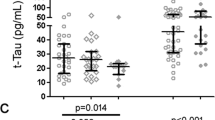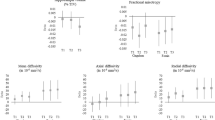Abstract
HIV produces a chronic viral infection of the central nervous system that elicits chronic glial activation and overexpression of glial cytokines1–5 that are also implicated in Alzheimer disease (AD) pathogenesis6–11. A genetic risk factor for AD is the E4 isoform for apolipoprotein E (APOE)12,13. Here we compare the frequency of neurologic symptoms for subjects with and without the E4 isoform (E4(+)and E4(–), respectively) in an HIV cohort14–17. Compared with E4(–) subjects, twice as many E4(+) subjects were demented (30% compared with 15%) or had peripheral neuropathy (70% compared with 39%) at least once, and they had threefold more symptomatic examinations (13% compared with 3% and 42% compared with 14%, respectively)(P < 0.0001). Thus, neurologic symptoms for HIV-infection and AD are linked through an etiologic risk factor. Long-term survivors of HIV infection with E4 may be at high risk for AD; conversely, gene–viral interactions may speed AD pathogenesis.
This is a preview of subscription content, access via your institution
Access options
Subscribe to this journal
Receive 12 print issues and online access
$209.00 per year
only $17.42 per issue
Buy this article
- Purchase on Springer Link
- Instant access to full article PDF
Prices may be subject to local taxes which are calculated during checkout

Similar content being viewed by others
References
Price, R.W. Neurological complications of HIV infection. Lancet 348, 445–452 (1996).
Navia, B.A., Cho, E.S., Petito, C.K. & Price, R.W. The AIDS dementia complex: II. Neuropathology. Ann. Neurol. 19, 525–535 (1986).
Mrak, R.E. & Griffin, W.S.T. The role of chronic self-propagating glial responses in neurodegeneration: Implications for long-lived survivors of human immunodeficiency virus. J. Neurovirol. 3, 241–246 (1997).
Dickson, D.W., Lee, S.C., Mattiace, L.A., Yen, S-H.C. & Brosan, C. Microglia and cytokines in neurological disease, with special reference to AIDS and Alzheimer's disease. Glia 7, 75–83 ( 1993).
Nuovo, G.J. & Alfieri, M.L. AIDS dementia is associated with masive, activated HIV-1 infection and concomitant expression of several cytokines. Mol. Med. 2, 358–366 (1996).
Meda, L. et al. Activation of microglial cells by beta-amyloid protein and interferon-gamma. Nature 374, 647–650 (1995).
Mackenzie, I.R., Hao, C. & Munoz, D.G. Role of microglia in senile plaque formation. Neurobiol. Aging 16, 797–804 (1995).
McGeer, P.L., Walker, D.G., Akiyama, H., Yasuhara, O. & McGeer, E. G. Involvement of microglia in Alzheimer's disease. Neuropathol. Appl. Neurobiol. 20, 191–192 (1994).
Klegeris, A., Walker, D.G. & McGeer, P.L. Interaction of Alzheimer beta-amyloid peptide with the human monocytic cell line THP-1 results in a protein kinase C-dependent secretion of tumor necrosis factor-alpha. Brain Res. 747, 114–121 (1997).
Vitek, M.P., Snell, J., Dawson, H. & Colton, C.A. Modulation of nitric oxide production in human macrophages by apolipoprotein-E and amyloid-beta peptide. Biochem. Biophys. Res. Commun. 240, 391–394 (1997).
Miyata, M. & Smith, J.D. Apolipoprotein E allele-specific antioidant activity and effects on cytotoxicity by oxidative insults and beta-amyloid. Nature Genet. 14, 55–61 (1996).
Strittmatter, W.J. et al. Apolipoprotein E: High avidity binding to beta-amyloid and increased frequency of type 4 allele in late-onset familial Alzheimer's disease. Proc. Natl. Acad. Sci. USA 90, 1977–1981 (1993).
Saunders, A.M. et al. Association of apolipoprotein E allele 4 with late-onset familial and sporadic Alzheimer's disease. Neurology 43, 1467–1472 (1993).
Hall, M. et al. The correlation between neuropsychological and neuroanatomic changes over time in asymptomatic and symptomatic HIV-1-infected individuals. Neurology 46, 697–702 (1996).
Robertson, K.R. et al. Vitamin B12 deficiency and nervous system disease in HIV infection. Arch. Neurol. 50, 807– 811 (1993).
Hall, C.D. et al. Cerebrospinal fluid analysis in human immunodeficiency virus infection. Ann. Clin. Lab. Sci. 22, 139– 143 (1992).
Robertson, K.R. & Hal, l.C.D. Human immunodeficiency virus-related cognitive impairment and the acquired immunodeficiency syndrome dementia complex. Semin. Neurol. 12, 18– 27 (1992).
Dunlop, O. et al. HIV dementia and apolipoprotein E. Acta Neurol Scand 95, 315–318 ( 1997).
Buttini, M. et al. Novel role of human CD4 molecule identified in neurodegeneration. Nature Med. 4, 441–446 (1998).
An, S.F. et al. Axonal damage revealed by accumulation of beta-APP in HIV-positive individuals without AIDS. J. Neuropathol. Exp. Neurol. 56, 1262–1268 (1997).
Giometto, B. et al. Accumulation of ß-amyloid precursor protein In HIV encephalitis: relationship with neuroppsychological abnbormalities. Ann. Neurol. 42, 34–40 ( 1997).
Nathan, B.O., Bellosta, S., Sanan, D.A. & Weisgraber, K.H. Differential effects of apolipoproteins E3 and E4 on neuronal growth in vitro. Science 264, 850–852 (1994).
Nicoll, J.A., Roberts, G.W. & Graham, D.I. Apolipoprotein E epsilon 4 allele is associated with deposition of amyloid beta-protein following head injury. Nature Med. 1, 135–137 ( 1995).
Menzel, H.J. & Utermann, G. Apolipoprotein E phenotyping from serum by Western blotting. Electrophoresis 7, 492–495 (1986).
SAS Institute, SAS/STAT Software: Changes and Enhancements through Release 6.11 (SAS Institute, Cary, North Carolina, 1996).
Acknowledgements
The authors thank J. Hartvigsen for help revising the manuscript. This study was supported in part by grants from the National Institute of Neurological Diseases and Stroke (P01-NS26680, R01-NS34234, R01-NS36518), National Institutes of Allergy and Infectious Diseases (AI-25868), the National Center for Research Resources (GCRC-RR00046), the National Institute on Aging (AG07198-09, P20-AG12852-02), the Gun and Bertil Stohne Stiftelsen and the Swedish Medical Research Council.
Author information
Authors and Affiliations
Corresponding author
Rights and permissions
About this article
Cite this article
Corder, E., Robertson, K., Lannfelt, L. et al. HIV-infected subjects with the E4 allele for APOE have excess dementia and peripheral neuropathy. Nat Med 4, 1182–1184 (1998). https://doi.org/10.1038/2677
Received:
Accepted:
Issue Date:
DOI: https://doi.org/10.1038/2677



